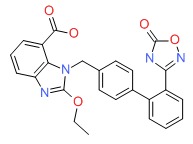NCBI Bookshelf. A service of the National Library of Medicine, National Institutes of Health.
LiverTox: Clinical and Research Information on Drug-Induced Liver Injury [Internet]. Bethesda (MD): National Institute of Diabetes and Digestive and Kidney Diseases; 2012-.

LiverTox: Clinical and Research Information on Drug-Induced Liver Injury [Internet].
Show detailsOVERVIEW
Introduction
Azilsartan is an angiotensin II receptor blocker (ARB) used in the therapy of hypertension. It is associated with a low rate of transient serum aminotransferase elevations, but has yet to be linked to instances of acute liver injury.
Background
Azilsartan (ay" sil sar' tan) is an ARB used alone or in combination with other agents for therapy of hypertension. Azilsartan inhibits the renin-angiotensin system by blocking the angiotensin II type 1 receptor (AT1), which prevents the vasoconstriction and volume expansion induced by circulating angiotensin II and which accounts for its antihypertensive activity. Azilsartan was approved for use in the United States in 2011 (the eighth ARB approved for hypertension). Current indications are for treatment of hypertension, either alone or in combination with other antihypertensive agents. Azilsartan is available in 40 and 80 mg tablets under the trade name Edarbi. Fixed combinations of azilsartan (40 mg) with chlorthalidone (12.5 or 25 mg) are also available under the brand name Edarbyclor. The typical dose in adults in 40 to 80 mg once daily, and it is used long term. Side effects are uncommon, but may include headache, dizziness, fatigue, cough, gastrointestinal upset, and fetal toxicity. Several ARBs, but not specifically azilsartan, have been linked to a severe sprue-like enteropathy that typically arises after months or years of therapy and is unresponsive to gluten withdrawal, but resolves promptly with stopping the angiotensin receptor antagonist.
Hepatotoxicity
Azilsartan has been associated with a low rate of serum aminotransferase elevations that, in controlled trials, was no higher than with placebo therapy. These elevations were transient and rarely required dose modification. No specific instances of clinically apparent acute liver injury have been reported in association with azilsartan therapy, but it has been available for a limited time. Other ARBs have been linked to rare instances of symptomatic hepatotoxicity. The onset of liver injury is usually within 1 to 8 weeks of starting therapy and the serum enzyme pattern is typically hepatocellular with an acute hepatitis-like clinical syndrome. In some instances, cholestasis has developed which can be prolonged and relapsing, but ARB therapy has not been associated with vanishing bile duct syndrome or chronic liver injury. Immunoallergic manifestations (rash, fever, eosinophilia) are not common, nor is autoantibody formation.
Likelihood score: E* (Unproved but suspected rare cause of clinically apparent liver injury).
Mechanism of Injury
The cause of the minor serum aminotransferase elevations with azilsartan is not known. Azilsartan is metabolized at least in part by the liver, largely via CYP 2C9, but it has minimal drug-drug interactions.
Outcome and Management
The instances of acute liver injury reported with ARB use have been self-limited and have not resulted in acute liver failure or chronic liver injury. While corticosteroids have been used in cases of severe cholestasis due to ARBs, their efficacy has not been shown and their use is best avoided. Patients with azilsartan induced liver injury should probably avoid use of other ARBs, although cross sensitivity to liver injury among the members of this class of agents has not been shown.
References on the safety and potential hepatotoxicity of azilsartan are given in the Overview section on the Angiotensin II Receptor Antagonists.
Drug Class: Antihypertensive Agents, Angiotensin II Receptor Antagonists
Other Drugs in the Subclass, Angiotensin II Receptor Antagonists: Candesartan, Eprosartan, Irbesartan, Losartan, Olmesartan, Telmisartan, Valsartan
PRODUCT INFORMATION
REPRESENTATIVE TRADE NAMES
Azilsartan – Edarbi®
DRUG CLASS
Angiotensin II Receptor Antagonists
Product labeling at DailyMed, National Library of Medicine, NIH
CHEMICAL FORMULA AND STRUCTURE
| DRUG | CAS REGISTRY NO. | MOLECULAR FORMULA | STRUCTURE |
|---|---|---|---|
| Azilsartan | 147403-03-0 | C25-H20-N4-O5 |
 |
- Effect of Switching to Azilsartan From Fixed-Dose Combination of an Angiotensin II Receptor Blocker and Calcium Channel Blocker or a Thiazide in Patients With Hypertension.[J Clin Med Res. 2019]Effect of Switching to Azilsartan From Fixed-Dose Combination of an Angiotensin II Receptor Blocker and Calcium Channel Blocker or a Thiazide in Patients With Hypertension.Miyoshi T, Onoue G, Ito H. J Clin Med Res. 2019 Mar; 11(3):202-207. Epub 2019 Feb 13.
- Review Angiotensin II Receptor Antagonists.[LiverTox: Clinical and Researc...]Review Angiotensin II Receptor Antagonists.. LiverTox: Clinical and Research Information on Drug-Induced Liver Injury. 2012
- Antihypertensive efficacy and safety of the angiotensin receptor blocker azilsartan in elderly patients with hypertension.[Drug Chem Toxicol. 2017]Antihypertensive efficacy and safety of the angiotensin receptor blocker azilsartan in elderly patients with hypertension.Kamada T, Hayashi M, Fujiwara W, Yoshikawa D, Mukaide D, Sugishita Y, Yoshinaga M, Itoh T, Yokoi H, Ishii J, et al. Drug Chem Toxicol. 2017 Jan; 40(1):110-114. Epub 2016 Jul 17.
- Ability of the new AT1 receptor blocker azilsartan to block angiotensin II-induced AT1 receptor activation after wash-out.[J Renin Angiotensin Aldosteron...]Ability of the new AT1 receptor blocker azilsartan to block angiotensin II-induced AT1 receptor activation after wash-out.Miura S, Matsuo Y, Nakayama A, Tomita S, Suematsu Y, Saku K. J Renin Angiotensin Aldosterone Syst. 2014 Mar; 15(1):7-12. Epub 2013 Apr 5.
- Review Differential pharmacology and benefit/risk of azilsartan compared to other sartans.[Vasc Health Risk Manag. 2012]Review Differential pharmacology and benefit/risk of azilsartan compared to other sartans.Kurtz TW, Kajiya T. Vasc Health Risk Manag. 2012; 8:133-43. Epub 2012 Feb 28.
- Azilsartan - LiverToxAzilsartan - LiverTox
Your browsing activity is empty.
Activity recording is turned off.
See more...